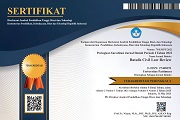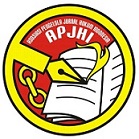Legal Democratization of the Existence of Indigenous Peoples
 )
)
(1) Faculty of Law Pattimura University, Ambon, Indonesia
 Corresponding Author
Corresponding Author
Abstract
Keywords
DOI
10.47268/ballrev.v4i1.1518
Published
2023-05-02
How To Cite
@article{BALLREV1518,
author = {Ekberth Noya},
title = {Legal Democratization of the Existence of Indigenous Peoples},
journal = {Batulis Civil Law Review},
volume = {4},
number = {1},
year = {2023},
keywords = {Indigenous Peoples, Legal Democratization; Cultur},
abstract = {This article describes the position of indigenous peoples who are starting to be marginalized due to the democratization process of existing laws. This article aims to show how far the process of legal democratization has progressed so that indigenous peoples are often marginalized while the law should uphold human rights. The research method used is the normative research method, and the research approaches used are the statute approach, the conceptual approach, and the analytical approach, so that they can help examine and find good research results. The democratic method begins with the freedom of the right to vote, which allows every citizen to participate in making political decisions. Each participant has equal rights in determining their own choices and also has the opportunity to be elected. The principle of a majority vote is essential to reaching decisions in the concept of democracy. "Democracy" contains three phenomena at once, namely political phenomena (power), ethical phenomena (moral teachings), and legal phenomena, which mutually form this theory with a theoretical basis that firmly rejects the authoritarian and totalitarian (political) order of power. It is based on this method that the rights and customs of indigenous peoples are increasingly marginalized.},
issn = {2746-8151}, pages = {86--94} doi = {10.47268/ballrev.v4i1.1518},
url = {https://fhukum.unpatti.ac.id/jurnal/ballrev/article/view/1518}
}
Abdulrahman. (1984). Hukum Adat Menurut Perundang-Undanga Republik Indonesia. Cendana Press.
Asshiddiqie, J. (2012). Hukum Tata Negara dan Pilar Demokrasi, Serpihan Pemikiran Hukum dan HAM. Konstitusi Press.
Astawa, I. G. P. (2009). Memahami Ilmu Negara dan Teori Negara. Refika Aditama.
Azra, A. (2000). Demokrasi, Hak Asasi Manusia, Masyarakat Madani. ICCE UIN Syarif Hidayatullah.
Fatah, S. (1994). Masalah dan Prospek Demokrasi di Indonesia. Ghalia Indonesia.
Freeman, M. D. A. (2001). Lloyd’s Introduction to Jurisprudence. Sweet & Maxwell Ltd.
Fuady, M. (2010). Konsep Negara Demokrasi. Refika Aditama.
H, D., Sujadi, F., Dian, A., Ambarjaya, B. S., Rahmatia, D., UW, J., S, D., & Sulfiawan, W. (2016). Pedoman Umum Penyelenggaraan Pemerintaha Desa: Landasan Hukum dan Kelembagaan Pemerintahan Desa. Media Pustaka.
Hadikusuma, H. (1981). Hukum Ketatanegaraan Adat. Alumni.
Hadikusuma, H. (2003). Pengantar Ilmu Hukum Adat Indonesia. Mandar Maju.
Hazairin. (1970). Demokrasi Pancasila. Bina Aksara.
Huntington, S. P. (1995). Gelombang Demokrasi Ketiga. Grafiti Press.
Ilmar, A. (2014). Hukum Tata Pemerintahan. Prenada Media Group.
Kansil, C. S. T. (2008). Hukum Tata Negara Republik Indonesia. Jakarta: Rineka Cipta.
Kelsen, H. (2018). Teori Umum Tentang Hukum dan Negara (R. Muttaqien (trans.)). Nusa Media.
Manan, A. (2003). Hukum Islam Dalam Berbagai Wacana. Pustaka Bangsa Press.
Muhammad, B. (1998). Azas-Azas Hukum Adat Suatu Pengantar. Pradnya Paramita.
Nashir, H. (1999). Pragmatisme Politik Kaum Elite. Pustaka Pelajar.
Nurtjahjo, H. (2006). Filsafat Demokrasi. Sinar Grafika Offset.
Pide , A. S. M. (2014). Hukum adat : dahulu, kini, dan akan datang.
Soehardi, A. (1954). Pengantar Hukum Adat Indonesia. S-Gravenhage.
Soehino. (2000). Ilmu Negara. Liberty.
Soekarno. (2005). Dibawah Bendera Revolusi. Yayasan Bung Karno.
Soepomo, R. (1993). Hukum Adat. Pradnya Paramita.
Sorensen, G. (2014). Demokrasi Dan Demokratisasi (Proses dan Prospek dalam Sebuah Dunia yang Berubah). Pustaka Pelajar.
Sudiyat, I. (1989). Azas-Azas Hukum Adat. Liberty.
Sulardi. (2012). Menuju Sistem Pemerintahan Presidensiil Murni. Setara Press.
Tutik, T. T. (2011). Konstruksi Hukum Tata Negara Indonesia Pasca Amandemen. Kencana Prenada Media Group.
Van Vollenhoven, C. (1987). Penemuan Hukum Adat. Djambatan.
Wattimena, J. A. Y., & Leatemia, W. (2021). Legal Legitimacy of Indigenous Peoples’rights In Natural Resources Management: The Case In Seram Barat. Awang Long Law Review, 4(1), 142–151.
Wikipedia. (n.d.). Masyarakat adat. Wikipedia.Org. https://en.wikipedia.org/wiki/Masyarakat_adat
| Dublin Core | PKP Metadata Items | Metadata for this Document | |
| 1. | Title | Title of document | Legal Democratization of the Existence of Indigenous Peoples |
| 2. | Creator | Author's name, affiliation, country | Ekberth Vallen Noya; Faculty of Law Pattimura University, Ambon; Indonesia |
| 3. | Subject | Discipline(s) | |
| 3. | Subject | Keyword(s) | Indigenous Peoples, Legal Democratization; Cultur |
| 4. | Description | Abstract | This article describes the position of indigenous peoples who are starting to be marginalized due to the democratization process of existing laws. This article aims to show how far the process of legal democratization has progressed so that indigenous peoples are often marginalized while the law should uphold human rights. The research method used is the normative research method, and the research approaches used are the statute approach, the conceptual approach, and the analytical approach, so that they can help examine and find good research results. The democratic method begins with the freedom of the right to vote, which allows every citizen to participate in making political decisions. Each participant has equal rights in determining their own choices and also has the opportunity to be elected. The principle of a majority vote is essential to reaching decisions in the concept of democracy. "Democracy" contains three phenomena at once, namely political phenomena (power), ethical phenomena (moral teachings), and legal phenomena, which mutually form this theory with a theoretical basis that firmly rejects the authoritarian and totalitarian (political) order of power. It is based on this method that the rights and customs of indigenous peoples are increasingly marginalized. |
| 5. | Publisher | Organizing agency, location | Faculty of Law, Universitas Pattimura |
| 6. | Contributor | Sponsor(s) | Faculty of Law Pattimura University, Ambon |
| 7. | Date | (YYYY-MM-DD) | 2023-05-02 |
| 8. | Type | Status & genre | Peer-reviewed Article |
| 8. | Type | Type | |
| 9. | Format | File format | |
| 10. | Identifier | Uniform Resource Identifier | https://fhukum.unpatti.ac.id/jurnal/ballrev/article/view/1518 |
| 10. | Identifier | Digital Object Identifier | 10.47268/ballrev.v4i1.1518 |
| 11. | Source | Title; vol., no. (year) | Batulis Civil Law Review; Vol 4, No 1 (2023): VOLUME 4 ISSUE 1, MAY 2023 |
| 12. | Language | English=en | en |
| 13. | Relation | Supp. Files | |
| 14. | Coverage | Geo-spatial location, chronological period, research sample (gender, age, etc.) | |
| 15. | Rights | Copyright and permissions | Copyright: Authors who publish their manuscripts in this Journal agree to the following conditions: 1. The copyright in each article belongs to the author, as well as the right to patent. 2. Authors are able to enter into separate, additional contractual arrangements for the non-exclusive distribution of the journal's published version of the work (e.g., post it to an institutional repository or publish it in a book), with an acknowledgment of its initial publication in this journal. 3. Authors are permitted and encouraged to post their work online (e.g., in institutional repositories or on their website) prior to and during the submission process, as it can lead to productive exchanges, as well as earlier and greater citation of published work. 4. Authors have the right to self-archiving of the article (Author Self-Archiving Policy)
Licence : Batulis Civil Law Review Journal is disseminated based on the Creative Commons Attribution-NonCommercial 4.0 International license terms. This license allows anyone to copy and redistribute this material in any form or format, compose, modify, and make derivatives of this material for any purpose. You cannot use this material for commercial purposes. You must specify an appropriate name, include a link to the license, and certify that any changes have been made. You can do this in a way that is appropriate, but does not imply that the licensor supports you or your use.
|
Copyright (c) 2023 Ekberth Vallen Noya

This work is licensed under a Creative Commons Attribution-NonCommercial 4.0 International License.

 : 1737 times
: 1737 times Download : 1074 times
Download : 1074 times














